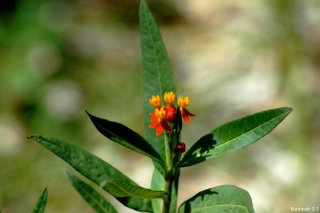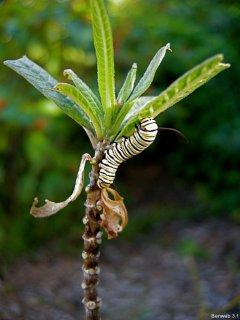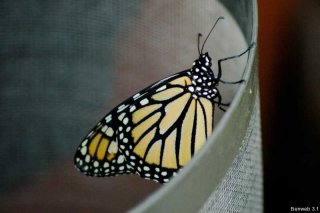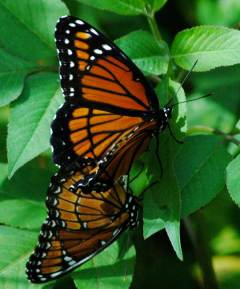Ficus benjamina, one of my least favorite plants in all of Florida for its aggressive growth habit and its ability to siphon up all the water you care to lavish on your yard anywhere (we had a huge hedge of it out front before we redid the whole yard, replacing it with Chrysobolanus icaco, or cocoplum), does have at least one interesting property: it is a laticiferous plant.* That is, it produces latex (the non-vulcanized rubber kind, not the typesetting software–that’s usually spelled LaTeX) in quantity. (Ask anyone with sensitive skin how much fun it is to trim a ficus hedge, and they’ll give you new insight into the phrase “where the rubber hits the road.”)
In its laticiferousness, though, F. benjamina is like one of the few non-native plants that I actually welcome in my yard: Asclepias curassavica, scarlet milkweed:
The reason I like the milkweed plant is that it is very attractive to a very attractive butterfly, the Monarch (Danaus plexippus)
A very similar butterfly, the Viceroy (Limenitus archippus), doesn’t feed on milkweed to acquire its chemical defense. Instead, it feeds on the Carolina willow (Salix caroliniana), which here in South Florida we call the Coastal Plain Willow. It differs in growth form, not in species name. Anyhoo, here’s a picture of a pair of viceroys enjoying a private moment at one of my favorite South Florida parks, Fern Forest:
Monarch butterflies like milkweed because their larvae feed on it, and in doing so, acquire a chemical defense that most of their predators are unwilling to attempt to overcome. It turns out that the Asclepias plants contain defensive steroids (cardenolides) that the caterpillars ingest, thereby acquiring a potent defense against predation. But in order to ingest the chemicals, they have to overcome the physical defense of the latex. And for this, they have a most ingenious trick, first performed by modern humans in 1905 by a certain H. Kniep. According to Thomas Eisner’s For Love of Insects,
Kniep was fascinated by the fact that slugs refused to eat certain laticiferous plants of the family Euphorbiaceae, so he decided to see whether it was on account of the latex. He found that he could drain the latex from the euphorbs by repeatedly puncturing the leaves, so he proceeded to treat one group of the plants in this fashion, while keeping another group untreated as controls. To what must have been his great satisfaction, he found that while the slugs spared the controls, they left little trace of the treated counterparts. (282)
One of Eisner’s doctoral students demonstrated that some insects have known of this trick (taking the latex out of laticiferous plants) for, presumably, thousands of years. What the insects do is puncture the midvein of the leaf, allowing the latex to flow right out of the laticiferous network (which is not contained in the veins, but which does parallel them so it appears as though the latex is flowing in the veins of the plant), enabling the insect to munch happily on the distal portion of the leaf, beyond the cut.
Eisner’s description of the technique leaves no doubt that it was insects defusing a latex bomb to get their meal that I “observed” in my garden as I was watching the caterpillars eating. However, preoccupied as I was with making sure I had identified the caterpillar correctly (Although I am a certified Florida Master Naturalist, I’m not a naturalist by trade, so what comes “naturally” to a some naturalists comes painfully and slowly to me), I didn’t even notice how they were going about their feeding. But I do now recall seeing numerous bent-in-half milkweed leaves, caused by this method of feeding (and next time I witness this behavior, you can be sure I’ll take pictures!).
Thus was solved a mystery that I hadn’t even thought to regard as a mystery until I read Eisner’s book and saw that I’d missed seeing something that was right in front of my face. That’s the life of a naturalist: you can spend days looking at a tiny patch of ground, investigating one phenomenon or another, and another naturalist, with a different approach entirely, can find out something else about your very own study site.
*I first learned this hard word in reading Thomas Eisner’s lovely book, For Love of Insects, in a chapter called “The Circumventers,” which is all about how certain insects overcome the defenses of other insects, or plants. There’s a recent paper about the viceroy’s acquisition of defensive chemicals; Eisner’s book doesn’t mention viceroys.




